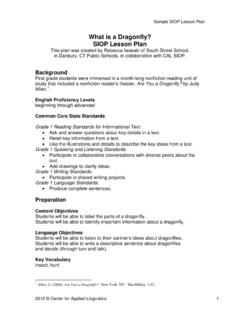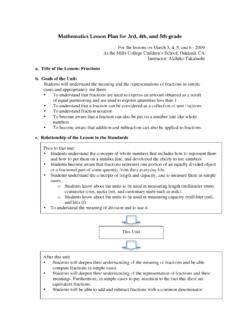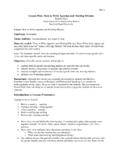Transcription of Social Skills Lesson Plan - LSU Human …
1 Social Skills Lesson plan Teacher: Date: Lesson Number: Skill: Objectives: Materials Needed: plan : Introduction Step: Did I complete the step? 1. Review group rules. Ask students if they remember the rules. Review quickly what each rule means. -Raise your hand before speaking -Use materials appropriately -Be kind to self and others -Confidentiality: what we say in here, stays in here! 2. Review group and/or personal goal(s) -To participate in class and interact with teachers without getting upset -To play with my friends, classmates, siblings, and cousins without fighting -To act calmly at home and get along with parents 3. Share homework assignment from last week. Direct Instruction (Tell) Step: Did I complete the step? 1.
2 Define the skill: taking no for an answer means that when an adult or peer tells you no you will react in a calm and positive manner without arguing 2. Why is it important? Ask the students why they think it is important (give feedback) -Helps you get along with others (teachers, parents, friends) Ms. Chenier Students will learn the necessary skill to accept no for an answer in a positive, productive manner. They will learn and practice the necessary steps. Student will participate in activities where they create different examples, role-plays, and scenarios that involve accepting no for an answer appropriately. Feedback from Ms. Chenier and from peers will be provided. Students will learn cues to let them know when the skill should be performed.
3 Video link, computer to play link, marker or colored pencils, paper, coach cards, parent take-home, homework assignment, self-monitoring sheet for students, monitoring for teachers 1 Accepting no for an answer -You can t always do what you want in school or at home but you still need to participate appropriately -If you accept no , the person might be more likely to say yes next time! 3. Video: -Ask students: What were the four steps in the video? 1. Look at the person 2. Say ok 3. Stay calm 4. If you disagree, ask about it later -Ask students: what does taking no for answer mean? 4. Social Story: Accepting No for an Answer. Read student the story and discuss. Sometimes it is hard for me to accept no . I get upset, and begin to argue.
4 This causes me to get in trouble. I can stay calm and say ok . If I disagree, I can ask my teacher later. I will try to say ok when my teacher tells me no . Did I provide performance feedback? Provide Examples and Non-Examples (Tell) Step: Did I complete the step? Examples: 1. You ask your teacher if you can go to the bathroom and she tells you no because the class will be going to lunch in 10 minutes. You say okay , take a deep breath and continue your work. Ask: How do you think you would feel in this situation? What do you think would happen? 2. You ask your friend if you can have a turn playing a game and they say no . You say okay, take a deep breath, find something else to play with and then ask your friend if you can have a turn later (in 10 minutes).
5 Ask: How do you think you would feel in this situation? What might happen? Ask the group to provide some examples Non-Examples 1. You ask your teacher if you can go to the bathroom and she tells you no because the class will be going to lunch in 10 minutes. You get angry and refuse to do your work. When your teacher asks you to keep working, you throw your paper on the ground. Ask: How do you think you would feel in this situation? What might happen next? 2. You ask your friend if you can have a turn playing a game and they say no . You grab it from them and run away with it. The friend chases you and you end up getting in a fight. Ask: How do you think you would feel in this situation? What will probably happen next? Ask the group to provide some non-examples Guided drawing activity.
6 Use one of the group examples or create your own! "Draw a picture of you asking your teacher for something." a. Show/Draw what you will ask her for b. Show/Draw her saying no c. Show/Draw how you responded d. Show the teacher praising you for accepting "no" e. Share picture with the group Did I provide performance feedback? Modeling and Role-Play (Show) Step: Did I complete the step? Teacher Modeling: 1. Show the students how you would perform the skill. Let them give you feedback as to how you did! 2. Walk the students through the thought process associated with each step. Teacher-Directed Role-Play: 1. Role play #1: Good example: You ask a friend if you can have some of their hot chips and they say no . Act out the right way to handle the situation.
7 Get students feedback as to what the child did that was good! 2. Role-play #2: Good example: You want to help your teacher collect the homework but your teacher says no because it is someone else s turn. Show us the right way to handle the situation. Get students feedback as to what the child did that was good! 3. Role-play #3: Bad example: You ask your mom if you can stay up an extra 30 minutes to finish watching a TV show and she says no . Show us the wrong way to handle it. Get students feedback as to what the child did that wasn t so good and how they could have handled it better. Do the role-play again using the feedback provided. 4. Ask the students to come up with some role-play scenarios and choose one or two. Did I provide performance feedback?
8 Scenarios (Show/Do) Step: Did I complete the step? 1. Social Story: Accepting No for an Answer. Re-read story. Sometimes it is hard for me to accept no . I get upset, and begin to argue. This causes me to get in trouble. I can stay calm and say ok . If I disagree, I can ask my teacher later. I will try to say ok when my teacher tells me no . 2. Brainstorm with the students different situations where the skill might be applied. Are there other times they might need it besides the ones already discussed? -school principal -other family members -extracurricular activities: church, sports, dance, music, etc -public places: amusement park, movie theater, grocery store Did I provide performance feedback? Performance Feedback/Reinforcement (Do) Step: Did I complete the step?
9 1. Show the students and let them practice by playing the game Mother may I? Provide feedback as to how they handle being told no . 2. Give the students 5 minutes of free-play and watch for opportunities to provide feedback about the use of the skill. Program for Generalizability/Reinforcement (Do) Step: Did I complete the step? 1. Give the students a coach card that lists the skill steps. Let them know they can use it when they are confronted with a situation where they are told no to help remind them of the skill steps. 2. Brainstorm ideas as a group about what types of cues might let them know it is time to use the skill. 3. Let the teacher(s) of the group members know what skill they are working on and have the teacher reward them with praise when they use the skill.
10 Have the teacher(s) let you know who uses the skill appropriately throughout the week so you can give the child(ren) a certificate of mastery for this skill. Let the kids know their teachers will be watching for this! Have the students put the skill steps on a poster to post in their classroom to help cue them! Homework Progress Monitoring plan Send home a short description to parents of this week s skill and how to use it. Ask parents to please look for the skill being used appropriately at home and to provide a lot of praise when it is used right. Homework: Think of a book, movie, or TV show where one of your favorite characters is told no when they ask for something they really want. Write about how they handled it and include one way they handled it well and one way they could have handled it better.







